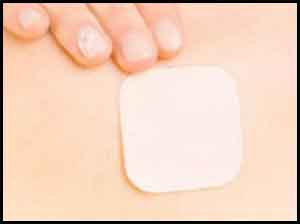- Home
- Editorial
- News
- Practice Guidelines
- Anesthesiology Guidelines
- Cancer Guidelines
- Cardiac Sciences Guidelines
- Critical Care Guidelines
- Dentistry Guidelines
- Dermatology Guidelines
- Diabetes and Endo Guidelines
- Diagnostics Guidelines
- ENT Guidelines
- Featured Practice Guidelines
- Gastroenterology Guidelines
- Geriatrics Guidelines
- Medicine Guidelines
- Nephrology Guidelines
- Neurosciences Guidelines
- Obs and Gynae Guidelines
- Ophthalmology Guidelines
- Orthopaedics Guidelines
- Paediatrics Guidelines
- Psychiatry Guidelines
- Pulmonology Guidelines
- Radiology Guidelines
- Surgery Guidelines
- Urology Guidelines
A Painless Skin Patch Simplifies Diagnostic Tests

A Painless Skin Patch Simplifies Diagnostic Tests. In the new test, a unique paper on the patch’s backing stores small amounts of Interstitial fluid, where it remains for analysis. Researchers think the Interstitial fluid (ISF) patch will simplify diagnostic testing and enable the continuous monitoring of biomarkers.
Many diagnostic tests require blood, but NIBIB-funded researchers have developed a skin patch with tiny needles that painlessly collect interstitial fluid (ISF) for testing. Diagnostic tests can measure trace amounts of essential proteins or hormones in the blood called biomarkers. High or low levels of biomarkers are specific indicators for a disease. Monitoring biomarkers is crucial because doctors routinely use them to diagnose and monitor patients at risk for cancer, heart disease, and diabetes.
Interstitial fluid fills the space between cells throughout the body and contains most of the same biomarkers found in the blood. ISF lacks cells and clotting agents, which can complicate blood analysis, thereby making it an attractive target for diagnostic testing. Many groups have started using ISF for diagnostic testing, but Mark Prausnitz, Ph.D., a Regents’ Professor of chemical and biomolecular engineering at Georgia Institute of Technology, thought the procedure for analyzing ISF could be simplified.
Prausnitz and his team, in collaboration with Srikanth Singamaneni, Ph.D., a professor of mechanical engineering and materials science at Washington University, used surface-enhanced Raman scattering (SERS)to speed up the analysis. This technique measures the amount of molecule by detecting its unique light scattering pattern. Negatively charged gold nanorods are incorporated into the paper on the patch’s backing and trap the positively charged biomarker of interest in the ISF.
Their results, published in ACS Sensors, show that the nanorods successfully attracted a positively charged molecule that researchers had injected into rats’ bloodstream that is absorbed in their ISF. The interaction between the nanorods and the trapped molecules amplified the Raman scattering so they could analyze it with SERS with enhanced sensitivity. The researchers reported the new procedure to be as sensitive as the previous multi-step methods.
Prausnitz said, “As a next step, we can adapt the methods we use to trap molecules in ISF to be more selective, using antibodies specific to a certain biomarker. In the future, we could create capture methods for multiple biomarkers all in the same patch.” The researchers say the patch can speed diagnostic testing, is designed to take less effort than previous methods, and can be produced in mass quantities at low cost.
“This is an excellent example of how rethinking common medical tests can lead to a new technology that may accelerate healthcare, especially the continuous monitoring of important biomarkers,” said Tiffani Lash, Ph.D., director of the NIBIB programs in Point-of-Care Technologies and Connected Health (mHealth and Telehealth). The next steps for the team are to continue further testing of the patch to ensure its safety for human use and its effectiveness for reliably detecting biomarkers of medical interest.

Disclaimer: This site is primarily intended for healthcare professionals. Any content/information on this website does not replace the advice of medical and/or health professionals and should not be construed as medical/diagnostic advice/endorsement or prescription. Use of this site is subject to our terms of use, privacy policy, advertisement policy. © 2020 Minerva Medical Treatment Pvt Ltd